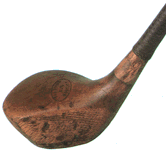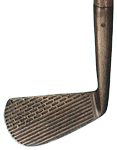A History of the Golf Club
Second Generation Golf Clubs
In 1826, a club-maker, Robert Forgan of Scotland, began to use hickory imported from America to manufacture shafts. This was quickly adopted as the wood of choice although the others continued to be used - perhaps because of cost. 
The invention of the Guttie ball in 1848 by Rev. Adam Paterson quickly rendered longnoses obsolete. Instead bulgers were used to cope with increased stresses incurred by using the new ball. Bulgers closely resemble today's woods in that they have a bulbous head.
increased stresses incurred by using the new ball. Bulgers closely resemble today's woods in that they have a bulbous head.
Interestingly, professionals such as Allan Robertson, Old Tom Morris and Willie Park Snr had workshops making clubs and balls which were exported around the world. Back then golfers associated Scotland with golf equipment in the way that today we associate Switzerland with timepieces and as such it was an extremely lucrative trade.
By 1900, persimmon imported from America had replaced beech and other hard woods as the material of choice for club heads.  A popular alternative was aluminium in keeping with the tradition of hand-forging metal club heads. Indeed in 1902, E. Burr introduced groove-faced irons for increased backspin.
A popular alternative was aluminium in keeping with the tradition of hand-forging metal club heads. Indeed in 1902, E. Burr introduced groove-faced irons for increased backspin.
Although blacksmiths such as Thomas Horsburgh experimented with steel shafts since the late 1890s, they were only slowly adopted. The R&A only legalised them after the Prince Of Wales used them on the Old Course, St Andrews in 1929. Billy Burke was the first to win a major tournament with steel shafted clubs when he won the US Open in 1931.
...next page...
...previous page...

